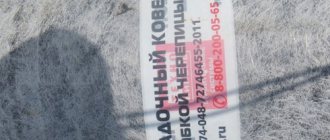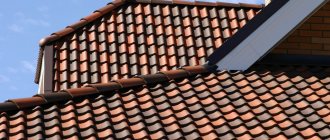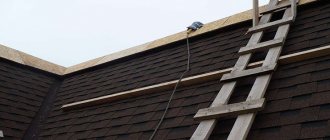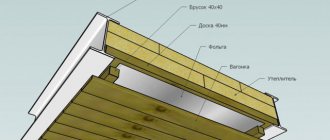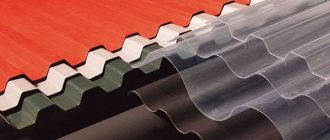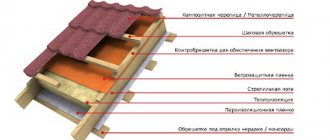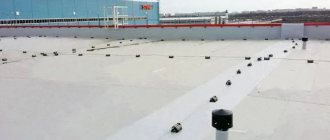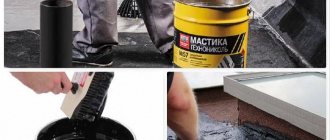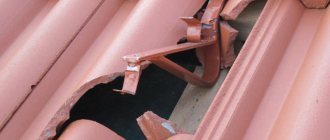Soft (bitumen) shingles are a relatively new building material. Its basis is fiberglass , impregnated with bitumen on both sides.
This design provides the material with fire resistance, moisture resistance and elasticity, allowing the tiles to be mounted on pies with curves and complex details.
During production, mineral chips of different shapes and colors are applied to the surface of the tiles, which creates a wide range of design solutions.
It is especially appropriate to use the material when arranging roofs with large slope angles.
Roofing pie for soft roofing
This name refers to a soft roof structure that fills the space of the roof between its outer and inner edges, that is, the space inside the rafter frame . It consists of layers of various materials, each of which performs its own function. Because of its layering, the structure has a name similar to the name of the culinary product.
Roof pie under soft tiles improves the waterproofing properties of the roof and ensures its insulation. Separate layers are responsible for each of these functions; for example, to increase moisture resistance, a waterproofing layer is included in the cake. The number of components of the pie depends on the type of roof: insulated roofs require more layers.
Now let’s look at the roofing scheme for soft tiles in more detail.
The third option is almost perfect
Here the fourth layer of insulation is laid. This layer can significantly save money on heating your home.
To improve the insulation properties, it is recommended to use insulation that includes basalt. Then a waterproofing film is laid on the insulation, which solves some problems, for example, such as:
- reducing the overall thickness of the roofing pie;
- The insulation with this installation method breathes, and the film allows the moisture that has penetrated into the insulation to erode freely.
In this case, the vapor barrier materials in such a cake will be reliable protection against the penetration of any moisture and other liquid substances into the insulation. It is worth remembering that in this case the vapor barrier must be installed on the inside of the rafter system, overlapping it. Where the joints of the film are, you need to treat them with adhesive tape.
Pie for a cold roof
There is no need to insulate the roof in cases where the owners of the house do not intend to use the attic space as a living space. The cold roof pie has a relatively simple structure and consists of six layers:
- Tile covering.
- An underlayment that enhances the protective properties of tiles and acts as a waterproofing agent.
- The covering is made of OSB (oriented strand board) boards, designed for use in high humidity conditions.
- Lathing.
- Waterproofing.
- Rafter frame.
Soft tiles, unlike metal profiles, require additional linings that fix and strengthen the position of the covering.
Waterproofing is needed to prevent the formation of condensation in the internal space of the roof . It can be placed not only under the sheathing, but also in front of it.
Basic recommendations
Once the decision has been made to complete the roof of the house using soft tiles, you need to think about laying it yourself. Installation is not difficult, but the technology has some peculiarities. The following recommendations for performing the work can be given:
Roofing pie for soft tiles
- After purchase, the material is stored indoors. The sheets are laid horizontally in pallets, the height of which is no more than 16 rows. The lining carpet, which is used for priming and leveling the surface under the tiles, is placed in a vertical position for storage.
- To create favorable temperature conditions in the under-roof space, you will need to perform thermal insulation. The type of insulation is selected depending on the preferences and financial capabilities of the home owner. Most often, mineral wool is installed. The technology for laying this material assumes the presence of reliable waterproofing and vapor barrier. In addition, to remove liquid vapor from the surface of the insulation, a ventilated air gap is provided between it and the roofing, the width of which is on average 5 cm.
- When purchasing roofing material, it is important to pay attention to the shipment of goods. The roof will look better if you use materials made at one time in one place. In this case, an exact match in color and physical characteristics can be guaranteed.
- Installation of soft tiles is not carried out at subzero temperatures. This is due to the fact that the material becomes brittle in the cold and can easily be damaged when secured into a pie.
- To lay the material yourself, the minimum slope angle should be 15 degrees. Installation with less does not guarantee waterproofing, since the liquid moves rather slowly over the surface and can easily flow into small gaps. In this case, it is worth considering the rule that for bitumen the roof slope cannot be too large and remember that the more the roof is sloped, the more material will be required per pie.
- Do-it-yourself installation of soft tiles is carried out without the use of a torch. This material does not belong to the class of weldable materials. For additional fastening (in case of strong wind loads), special adhesive solutions are used.
- Peel off the transparent protective film from the inner surface immediately before placing it on the cake.
- When doing work with your own hands, it is important to remember that you are not allowed to walk on the roof without special equipment in sunny, warm weather. This is because the material melts slightly when exposed to sunlight, and the person doing the installation may leave shoe marks on the surface that cannot be removed without replacing part of the coating.
- Solid material is used as a base for the tiles. The pie may include a continuous sheathing or a sparse one, followed by laying moisture-resistant plywood on it. Installation directly on the insulation is prohibited.
If you follow these recommendations, then a roof with flexible tile cladding will delight its owner for many years.
Mansard roof installation
If you intend to use the attic space for permanent or temporary residence (that is, transform it into an attic space), then thermal insulation of the roof becomes a necessary action . The insulation layer increases the thickness of the roofing pie and complicates its installation. Insulation also involves carrying out a vapor barrier to avoid the negative impact of the internal condensation of the room on its materials.
Thus, the roofing pie for soft tiles includes two additional layers . The completed design looks like this:
- Tile covering.
- Underlay carpet.
- OSB coating.
- Lathing.
- Waterproofing.
- Thermal insulation.
- Rafters.
- Vapor barrier.
soft roof pie with insulation
IMPORTANT!
Bitumen itself has good moisture-proofing properties, so laying a separate waterproofing layer is not necessary here , unlike installing a metal tile roof. But with a high slope angle and the presence of insulation, additional waterproofing will significantly increase the operational potential of the roof.
When laying the cake, it is important to leave small gaps between the layers to allow natural ventilation.
Additional materials on the topic
Snow retention on a soft roof
More details
Review of Finnish soft roofing
More details
Lightning protection on soft roofs
More details
Your feedback, comments, questions
Dear visitors! We will periodically answer your questions in the comments as we are busy. In order for us to respond to you promptly (within an hour), you can: call, write a personal message or leave a request for a free consultation by phone.
Comments
Eduard 09.19.2016 10:21
0 Two questions arose (your phone is always busy) 1. If I use your installation services, will you make a roofing project or will I have to order it from others. 2. Approximately what time will a full roof pie of a half-hip roof of 280 m2 rise?
Reply | Reply with quote | Quote Consultation by phone +7(495) 241-00-59 Answered by Mikhail moderator
Hello. Basically, we make the cake right away, the only thing is that if the facade is not ready, we cannot install soffits and drainpipes. On average, a full pie costs 1,800 rubles for the work. We also offer roofing materials at good discounts.
Update list of comments
Waterproofing and vapor barrier
If the roof slope angle is less than 18 degrees , the waterproofing layer is laid only on the most vulnerable places: ridge, overhangs, valleys , areas around pipes.
If the slope angle is more than 18 degrees , then waterproofing is laid over the entire roof area.
Moisture-proof materials are divided into liquid and solid. The first ones are applied to flat roofs or those with a small angle of inclination (up to 5%). If the roof has a greater slope, then materials are used in solid forms, such as film and roll.
Since soft tiles are laid mainly on sloping roofs, then we will talk specifically about hard waterproofing.
The highest quality moisture-resistant material is a waterproofing membrane . Its pores do not have a standard cylindrical shape, but a funnel-shaped one with a narrowing on the upper edge. This form allows condensation to escape freely from the interior of the roof, but does not allow moisture to enter.
- If special design solutions are not conceived, then waterproofing is laid between the rafters and the sheathing . It is fixed to the rafters using a construction stapler, and it should be fastened to the sheathing with self-tapping screws.
- Waterproofing of a soft roof is laid in the direction from the eaves to the ridge . The overlap between two sheets of material should not be more than 12 cm
- The sheets are fastened to each other using adhesive tape.
- The film or roll can sag in the space between the edges of the rafters, but no more than 20 mm . Such sagging will improve the ventilation capabilities of the roof.
Vapor barrier also protects the insides of the roofing pie from moisture, but, unlike waterproofing, it prevents moisture from entering from the interior of the house , and not from the environment. Its main function is to protect the insulation, so vapor barriers are rarely installed in cold roofs.
NOTE!
When choosing a vapor barrier material, you should pay special attention to its strength , since during the operation of the roof it will be subject to the pressure of the insulation.
The most popular materials for vapor barrier films are polyethylene and aluminum foil.
waterproofing the roof pie under a soft roof
The film is attached to the rafters using galvanized nails or staples. It is important to carefully connect all the joints, otherwise condensation will penetrate into the inside of the cake. As with the installation of waterproofing, it is necessary to leave a slight sagging of the film to improve internal ventilation. But if a vapor barrier is installed instead of a film, then sagging is unacceptable, the material must be tensioned.
Before installing all insulating layers, the rafters are treated with antiseptic impregnation.
Lathing requirements
Compared to metal tiles or other metal-based coatings, soft roofing has lower mechanical strength. Despite the light weight of the material, bitumen shingles are laid on a continuous sheathing, which is made from edged boards and chipboards impregnated with an antiseptic preparation. The base is prepared in 3 stages:
- First, a counter-lattice is attached parallel to the rafters on which the waterproofing film is laid. It is made from 3-4 cm thick coniferous timber to create a ventilation gap between the layers of the roofing pie.
- Then an additional lathing made of edged softwood boards measuring 150x20 mm is nailed onto the counter-lattice. Additional sheathing is attached perpendicular to the rafters in increments of 30-50 cm.
- A continuous base is laid on the additional sheathing, on which a lining pie is laid, and then bitumen shingles. It is made of moisture-resistant plywood.
Important! Knots, nicks and chips in wood damage the lower surface of the soft roof, so the base under it must be perfectly smooth and even. If the solid sheathing is made not from plywood, but from edged boards, then it must be planed and sanded.
Lathing requirements
Insulation of flexible tiles
Despite providing protection from moisture with vapor and waterproofing, the material for the insulation must also be sufficiently resistant to water so that it is not damaged by the slightest leakage of the protective layers.
Also important are criteria such as:
- Thermal conductivity. It should be as low as possible.
- Shape stability. The material should not deform at the slightest impact.
- Low density. Heavy insulation will push through the rafters and vapor barrier.
- Resistance to temperature changes.
- Fire resistance.
- Environmental friendliness. If the attic is used as a living space, it is important to choose materials that do not emit toxins.
- Soundproofing. Soft tiles do not create as much noise as metal tiles, but noise protection is still an important parameter.
The most popular materials for insulation are mineral wool, glass wool, polystyrene foam, penoizol, polyurethane foam. These materials are distinguished by their low cost and resistance to negative influences. But it is important to ensure their good insulation from the living space, since small particles of some types of insulation (for example, glass wool) are harmful to humans if they constantly enter the body.
CAREFULLY!
Before installing the insulation, provision should be made for creating gaps with both the waterproofing and the vapor barrier. This is necessary to ensure ventilation and prevent damage to materials when rubbing against each other.
Insulation of a soft roof is carried out in the following order:
- Nails are driven into the lower edges of the rafters at all corners at equal distances from each other.
- The thermal insulation material is slightly compressed and inserted into the space between the rafters.
- The cords are threaded between the driven nails and secured in a crosswise position; they are the ones who make the insulation securely fastened.
Instead of cords, you can use slatted wooden sheathing; it is attached not by diagonally crossing, but parallel to each other in increments of 40 centimeters.
Insulation of tiles is carried out by analogy with other coatings
Thermal insulation is usually laid in two layers . The insulation blocks should not protrude beyond the lower and upper planes of the rafters; otherwise, the materials must be trimmed.
These are the main components of the soft tile roofing cake. Its main difference is that the material of such a roof has good waterproofing, and the installation of a separate moisture-proof layer is not necessary, but all other necessary elements are similar to those of other types of tiles.
Which insulation is best?
Now we will find out which flat roof insulation is the best.
The most common material today is considered to be stone wool, followed by polystyrene foam and extruded polyurethane foam in the list of leaders.
Stone wool is considered the most suitable for insulating flat surfaces, polystyrene foam is the cheapest, and extruded polyurethane foam has a very successful set of characteristics that are ideal for the task.
At the same time, there are less common methods of insulation - for example, using expanded clay, which, being an excellent insulation material, can serve as a drainage layer for the outflow of penetrated moisture.
All materials require reliable water protection, and only expanded clay is not at all afraid of water and practically does not lose its properties when wet.
The only reason waterproofing is necessary is because water that penetrates can remain in the depressions and freeze during the winter, which can cause the concrete to deteriorate.
Styrofoam
Extruded polyurethane foam
